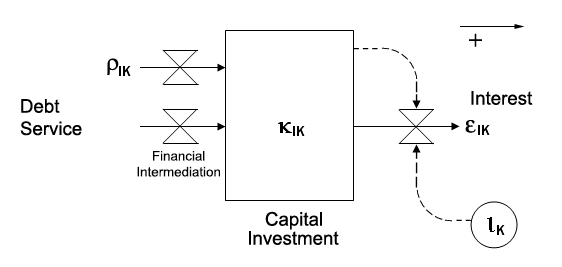The further one advances rightward on the political spectrum the more likely one will encounter devout sentiments to the effect that finance must be an entirely separate discipline from economics.1 SFEcon, having been reasonably characterized as the economics of securities analysis, is therefore comforted in knowing that we have nothing to lose in giving further offense to economic orthodoxy.
As shown below, a generic industrial sector IK's capital account kIK $ is continuously relieved by debt service on the left and continuously charged with financial services eIK=iK·kIK, where iK is (minus) economy K’s interest rate. An economy's interest rate -iK operates in the negative to effect the positive feedback attaching to financial positions: un-serviced debts and un-redeemed savings grow exponentially at the rate of interest.

By our convention, capital obligations kIK are positive quanta; and (minus) financial services eIK, being formed by the product of a positive and a negative, are negative. The action of financial services eIK therefore reverses its directional arrow in the figure above, and operates to heap-up financial obligations kIK. (Minus) debt service must also compute to a negative, which also reverses the direction of the arrow illustrating its flow, and therefore operates to reduce financial obligations.
Inspection of the signal path for a capital position kIK above points up the critical problem to be addressed in controlling the dynamics of economic adjustment:
We know that RIJK drives a physical process that is weakly self-reinforcing: though technical utility diminishes at the margin of an input’s application, production nonetheless rises with rising inputs. Economic science is thereby obligated to explain why production should not increase without limit, even with constant technology.
But any minimally faithful construction of economic control’s financial component begins by compounding the problem: financial positions are strongly self-reinforcing — which leaves us with a concept of economic dynamics as governed by the interaction of two positive feedback systems.Debt service must control the level of financial obligations kIK toward the ultimate goal of equating cash flows -rIK with dividends -eIK =-iK·kIK, and then resolve itself to iK·kIK just as financial stasis arrives. Debt service must therefore be decomposed into two terms: one of which is rIK itself; and the other we shall call financial intermediation. To this point, all we know of financial intermediation is that it somehow stabilizes the inherently ornery financial adjustment system until it contrives to vanish at stasis. Elucidation of the intermediary cannot commence until SFEcon’s method for price computation is fully established.
_____________________
1 Vox Day: "History's engine and the great bear wave".
World Net Daily, 13 July 2009. < full context >